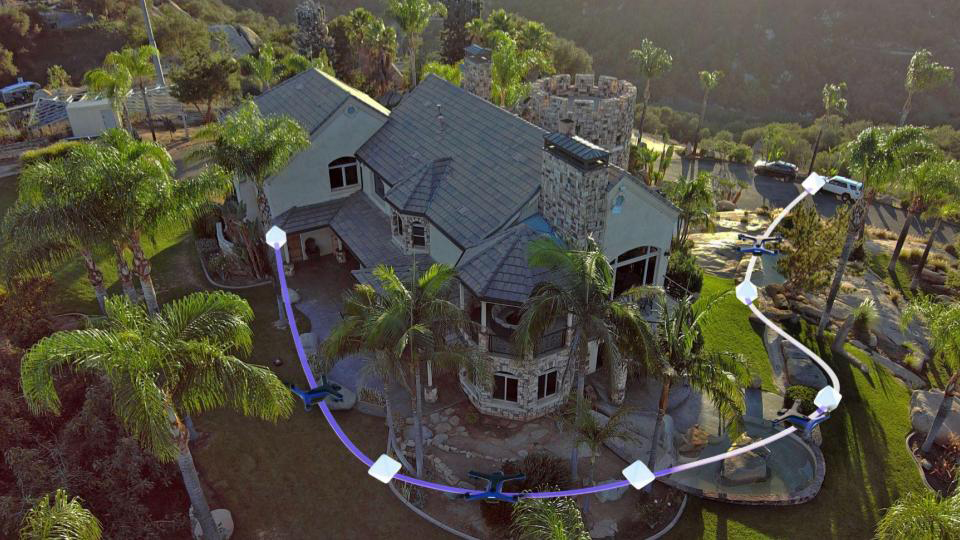Skydio 2+ drone lets amateur pilots pull off Hollywood-style camera moves
Keyframe feature is a big bonus for amateur fliers

The Skydio 2+ drone has landed at CES 2022 with some relatively minor hardware upgrades over its predecessor, but one big software feature could be a big deal for amateur pilots.
One of the toughest things for non-professional drone fliers to master is making seamless aerial camera moves around points of interest. But Skydio's new Keyframe feature, which will be available on both the Skydio 2+ and the Skydio 2 model it replaces, promises to make this much easier than current solutions, like waypoints or subject-tracking.
Videographers use 'keyframes' to define start and end points for moving sequences, along with any important frames in between. Waypoints let you achieve a similar function on drones, but Skydio's Keyframe feature promises to produce smoother results when you're making complex moves around subjects.
Rather than marking waypoints on a map, you simply fly your Skydio drone to a 'keyframe' moment in the air, save its location along with the camera angle you want, and move onto the next one until you've finished a sequence. Once you've chosen the speed you want it to fly at, the Skydio drone will automatically fly between the points to produce the video – while using its six-camera obstacle avoidance to stay safe.
It certainly sounds like a simpler and more versatile alternative to waypoints and subject-tracking, which are the fine on their own, but rarely combine well. DJI fans will hope the company creates something similar for drones like the DJI Mavic 3, which is still having its under-cooked feature set fleshed out following a rushed launch in December 2020.
Beyond the new Keyframe features, the hardware updates to the Skydio 2+ are relatively minor. There are two main improvements to the current Skydio 2 – it now has 5Ghz Wi-Fi connectivity, which boosts its range to 6km (3.7 miles), plus a new battery that slightly improves the drone's flight time to 27 minutes.
The Skydio 2+ is on sale now in the US and Canada, with prices starting at $1,099 (around £800 / AU$1,500). Skydio drones are currently only available to buy in the US, though the company has hinted at international expansion, with its enterprise models now available in Japan, Australia and New Zealand.
Get daily insight, inspiration and deals in your inbox
Sign up for breaking news, reviews, opinion, top tech deals, and more.
Analysis: a useful semi-automatic mode for amateurs

The image quality offered by consumer drones has improved greatly in recent years, with the recent DJI Mavic 3 coming with a huge Four Thirds sensor. But camera moves are just as important for the overall look of a video, and this is where Skydio's KeyFrames feature promises to improve the experience for amateurs.
Keyframes appears to sit in between current automated options like DJI's QuickShots (which are pre-scripted drone movements) and waypoints, which let you define a flight path for your drone on a map. Unlike the latter, the Skydio's new feature gives you a preview of each keyframe, because its path is based on your performing a dummy run around your chosen subject, and marking all the important shots.
The other benefit of this approach is that you should be able to avoid the slightly amateurish look of popular automated drone moves, like Helix or Rocket. These are easy to pull off, thanks to their one-button activation, but are a little too robotic and simplistic for pros.
Professional fliers will still likely rely on their own manual flying skills, rather than any automated drone modes (including Keyframes). But for amateurs who'd like to combine several drone moves in one shot, Skydio's Keyframes could be a popular new feature, if one that's still only available in the US and Canada for now.
- Check out all of TechRadar's CES 2022 coverage. We're bringing you all the breaking tech news and launches, everything from 8K TVs and foldable displays to new phones, laptops and smart home gadgets.

Mark is TechRadar's Senior news editor. Having worked in tech journalism for a ludicrous 17 years, Mark is now attempting to break the world record for the number of camera bags hoarded by one person. He was previously Cameras Editor at both TechRadar and Trusted Reviews, Acting editor on Stuff.tv, as well as Features editor and Reviews editor on Stuff magazine. As a freelancer, he's contributed to titles including The Sunday Times, FourFourTwo and Arena. And in a former life, he also won The Daily Telegraph's Young Sportswriter of the Year. But that was before he discovered the strange joys of getting up at 4am for a photo shoot in London's Square Mile.